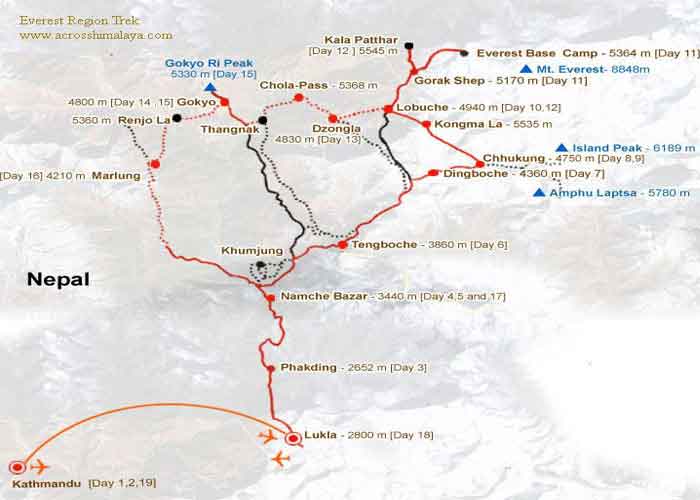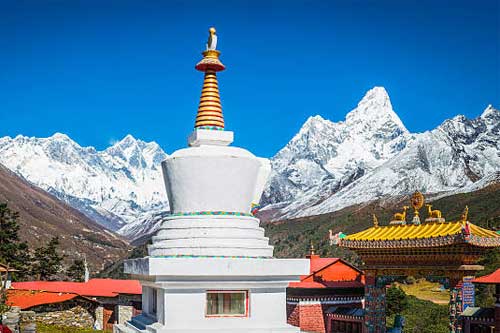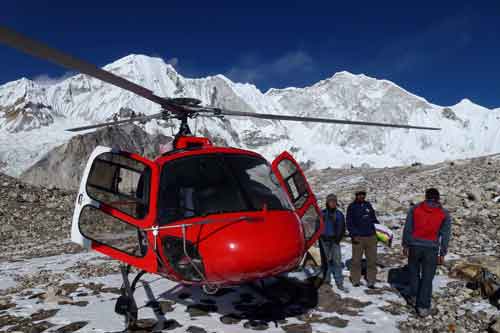Mera Peak Climbing

Mera Peak is one of the most popular trekking peaks in the Himalayas of Nepal. It is situated in the Sagarmatha National Park, in the Khumbu region, and stands at an altitude of 6,476 meters (21,247 feet). Climbing Mera Peak is a challenging and rewarding experience, offering stunning views of the Himalayan range and a sense of accomplishment upon reaching the summit.
The Mera Peak climbing expedition typically takes around 18-20 days to complete, including the trek to and from the peak. The trek to Mera Peak base camp starts with a scenic flight from Kathmandu to Lukla. From Lukla, the trek continues through beautiful Sherpa villages, lush forests, and high altitude valleys.
The climbing of Mera Peak involves crossing the Mera La Pass, which is located at an altitude of 5,415 meters (17,766 feet). After crossing the pass, the route becomes steeper, and climbers need to use ropes, ice axes, and crampons to climb the glacier. The final ascent to the summit involves climbing a steep snow slope, which can be physically demanding.
The best time to climb Mera Peak is during the autumn season (September-November) and spring season (March-May). Climbers should be well-prepared with appropriate equipment, clothing, and food for the journey. It is recommended to climb Mera Peak with an experienced guide and a team of climbers to ensure safety and support throughout the expedition.
Mera peak climbing Itinerary
Day 01: Arrival in Kathmandu
- Arrive in Kathmandu, the capital city of Nepal.
- Transfer to your hotel and meet your trekking guide.
- Attend a briefing session and prepare for the trek.
- Overnight stay in Kathmandu.
Day 02: Fly from Kathmandu to Lukla and trek to Paiya (Chutok)
- Take an early morning flight from Kathmandu to Lukla (about 35 minutes).
- Start trekking from Lukla and descend towards the Dudh Koshi River.
- Trek through beautiful forests and reach Paiya.
- Overnight stay in Paiya.
Day 03: Trek from Paiya to Pangkongma
- Trek through dense forests and ascend towards Pangkongma.
- Enjoy panoramic views of the surrounding landscapes.
- Overnight stay in Pangkongma.
Day 04: Trek from Pangkongma to Nashing Dingma
- Continue trekking through the Hinku Valley.
- Pass through remote settlements and experience the local culture.
- Reach Nashing Dingma and rest for the night.
Day 05: Acclimatization day in Nashing Dingma
- Take a day to acclimatize to the altitude.
- Explore the area and go for short hikes to higher altitudes.
- Overnight stay in Nashing Dingma.
Day 06: Trek from Nashing Dingma to Chhatra Khola
- Resume the trek and descend towards Chhatra Khola.
- Cross the river and hike through rhododendron forests.
- Reach Chhatra Khola and set up camp for the night.
Day 07: Trek from Chhatra Khola to Kothe
- Trek along the west bank of the Hinku Drangka River.
- Pass through the Gondishung village with its ancient Gompa (monastery).
- Continue to Kothe and spend the night there.
Day 08: Trek from Kothe to Thaknak
- Trek through the Hinku Valley and gradually ascend.
- Cross several streams and traverse the summer grazing areas.
- Reach Thaknak, a small settlement near the Hinku Nup Glacier.
- Overnight stay in Thaknak.
Day 09: Trek from Thaknak to Khare
- Continue the ascent and trek towards Khare.
- Enjoy magnificent views of Mera Peak and other surrounding peaks.
- Arrive in Khare, the base camp for Mera Peak climbers.
- Overnight stay in Khare.
Day 10: Acclimatization day in Khare
- Take a rest day to acclimatize and prepare for the summit push.
- Attend a training session on climbing techniques and safety.
- Overnight stay in Khare.
Day 11: Trek from Khare to Mera La
- Begin the climb towards Mera La Pass.
- Cross the pass and enter the upper Hinku Valley.
- Set up camp near Mera La and prepare for the summit bid.
- Overnight stay at Mera La.
Day 12: Summit Day (Mera Peak) and descent to Kongma Dingma
- Start early in the morning for the summit push.
- Ascend the snow slopes and reach the summit of Mera Peak (6,476 meters/21,247 feet).
- Enjoy breathtaking views of the Himalayas, including Mount Everest.
- Descend back to Mera La and continue down to Kongma Dingma.
- Overnight stay in Kongma Dingma.
Day 13: Reserve Day for Contingency
- Keep a reserve day in case of bad weather or other unforeseen circumstances.
- If the summit was successful on Day 12, this day can be used for extra rest or exploration.
- Overnight stay in Kongma Dingma.
Day 14: Trek to Seto Pokhari
- Resume the descent and trek towards Seto Pokhari (White Lake).
- Pass through beautiful alpine landscapes and small settlements.
- Overnight stay at Seto Pokhari.
Day 15: Trek from Seto Pokhari to Amphu Labtsa Base Camp
- Continue trekking through the Hinku Valley.
- Reach Amphu Labtsa Base Camp, the starting point for the Amphu Labtsa Pass crossing.
- Overnight stay at the base camp.
Day 16: Trek to Chukung
- Begin the challenging crossing of Amphu Labtsa Pass (5,845 meters/19,177 feet).
- Descend on the other side and reach Chukung.
- Overnight stay in Chukung.
Day 17: Trek to Tengboche
- Trek back to Tengboche, a famous Buddhist monastery in the Everest region.
- Enjoy the serene atmosphere and panoramic mountain views.
- Overnight stay in Tengboche.
Day 18: Trek to Namche Bazaar
- Descend further and trek back to Namche Bazaar.
- Explore the bustling market and celebrate the successful expedition.
- Overnight stay in Namche Bazaar.
Day 19: Trek down to Lukla
- Continue the descent and trek back to Lukla.
- Reflect on the journey and bid farewell to the mountains.
- Overnight stay in Lukla.
Day 20: Fly back to Kathmandu
- Take an early morning flight from Lukla to Kathmandu.
- Transfer to your hotel in Kathmandu.
- Rest and relax in the city or explore the local attractions.
- Overnight stay in Kathmandu.
Day 21: Departure from Kathmandu
- Depart from Kathmandu, either for home or your next destination.
Costs included:
- Climbing Permit: The cost of the climbing permit required for Mera Peak.
- A permit to enter the Everest region: Sagarmatha National Park entry fees. and TIMS (Trekkers' Information Management System) Card:
- Insurance, meals, accommodation, and wages for the climbing guide and support staff.
- Airport Transfers: Pick-up and drop-off services between the airport and your hotel in Kathmandu.
- Accommodation: Accommodation in Kathmandu before and after the trek, as well as during the trek in teahouses or lodges.
- Meals: Three meals a day (breakfast, lunch, and dinner) during the trekking portion of the expedition. Meals are usually provided in teahouses or lodges along the trail.
- Trekking Guide and Climbing Sherpa: An experienced trekking guide who leads the expedition and a climbing Sherpa who provides support during the climb.
- Porters: Porters to carry the necessary equipment and supplies during the trek.
- Climbing Equipment: Basic climbing equipment such as ropes, ice axes, crampons, harness, and helmets. However, personal gear like climbing boots and clothing are typically not included and need to be brought or rented separately.
- Food and Accommodation during the Climb: Food and accommodation in tents or high-altitude camps during the climb.
- High-Altitude Medical and Safety Equipment: Oxygen cylinders, first aid kits, and other necessary medical and safety equipment.
Costs excluded:
- International Flights: The cost of round-trip flights from your home country to Kathmandu, Nepal.
- Visa Fees: The cost of obtaining a tourist visa for Nepal.
- Travel Insurance: Personal travel insurance that covers trekking and climbing activities, including high-altitude rescue and medical expenses.
- Personal Climbing Gear: Personal climbing gear such as climbing boots, down jackets, thermal clothing, gloves, and sleeping bags. These can be rented or purchased in Kathmandu.
- Personal Expenses: Expenses for beverages, snacks, additional meals in Kathmandu, internet usage, and personal shopping.
- Tips: Tips for the trekking guide, climbing Sherpa, and porters. Tipping is a common practice in Nepal to show appreciation for their services.
- Additional Costs: Any additional costs incurred due to changes in the itinerary.
Fixed Departure Date
| Start Date |
Duration |
Trip Price | Availability | Book This Trip |
| 2024 /2025 | 21 Days | USD 2,895 | Conformed | Book Now |
Note: If the above departures dates are not matched for you may request own your suitable date!
Useful Information
Where is Mera Peak located?
- Mera Peak is located in the Everest region of Nepal, in the Solu Khumbu district. It lies to the south of Mount Everest and offers stunning views of the Himalayas.
What is the altitude of Mera Peak?
- The summit of Mera Peak stands at an altitude of 6,476 meters (21,247 feet) above sea level.
Do I need climbing experience to climb Mera Peak?
- Climbing Mera Peak requires basic mountaineering skills and previous trekking experience at high altitudes. While it is not technically demanding, it involves some sections of snow and ice climbing. It is highly recommended to have prior experience in using ice axes, crampons, and ropes. Training and guidance from experienced guides are essential.
Do I need a permit to climb Mera Peak?
- Yes, a climbing permit is required to climb Mera Peak. The permit can be obtained through a registered trekking agency in Nepal, and you will also need to be accompanied by a licensed climbing guide.
When is the best time to climb Mera Peak?
- The best time to climb Mera Peak is during the spring (April-May) and autumn (October-November) seasons. These months generally offer stable weather conditions, clear skies, and good visibility. However, weather in the mountains can be unpredictable, so it's essential to be prepared for changes.
How long does it take to climb Mera Peak?
- The duration of the climb varies depending on the specific itinerary and the trekking agency you choose. Typically, a Mera Peak climbing expedition takes around 18 to 20 days, including acclimatization days and the summit attempt.
Is it possible to climb Mera Peak without a guide?
- It is technically possible to climb Mera Peak without a guide, but it is highly recommended to hire an experienced climbing guide. A guide provides valuable assistance in terms of safety, route navigation, technical expertise, and local knowledge. They also help with logistics and ensure a better chance of a successful summit.
What kind of physical fitness is required for Mera Peak climbing?
- Climbing Mera Peak requires a good level of physical fitness. You should be prepared for long days of trekking, steep ascents, and endurance at high altitudes. Prior training, including cardiovascular exercises, strength training, and hiking with a backpack, is beneficial.
What are the accommodation and food options during the climb?
- Accommodation during the Mera Peak climb is typically in teahouses or lodges along the trekking route. These provide basic but comfortable facilities such as beds, blankets, and common dining areas. As for food, the teahouses offer a variety of meals, including Nepali, Tibetan, and international dishes. However, as you ascend higher, the menu choices become more limited.
Is it necessary to have travel insurance for Mera Peak climbing?
- Yes, having travel insurance that covers trekking and climbing activities is essential. The insurance should include emergency medical evacuation, trip cancellation/interruption, and coverage for high-altitude trekking/climbing.
Are there any risks involved in climbing Mera Peak?
- Climbing Mera Peak involves certain risks, including altitude sickness, avalanches, crevasses, and adverse weather conditions. However, with proper acclimatization, experienced guides, and safety precautions, the risks can be minimized. It's important to choose a reliable trekking agency with experienced guides to ensure a safe and successful climb.






